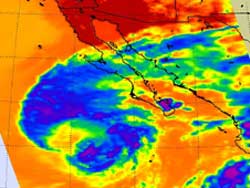NASA Sees a Western Weakness in Tropical Storm Miriam

This infrared image was created from AIRS data of Tropical Storm Miriam on Sept. 26 at 2047 UTC off the coast of Baja California. Strongest thunderstorms with very cold cloud top temperatures appear in purple surrounding north, east and south of the center of circulation. Credit: NASA JPL/Ed Olsen<br>
The Atmospheric Infrared Sounder (AIRS) instrument that flies aboard NASA's Aqua satellite captured infrared data on Tropical Storm Miriam on Sept. 26 at 2047 UTC, when it was off the coast of Baja California.
Strongest thunderstorms with very cold cloud top temperatures appear to surround north, east and south of the center of circulation. By Sept. 27, only the northern quadrant of the storm appeared to have those strong thunderstorms.
Miriam appears to be weakening quickly because of strong wind shear and cooler waters.
At 11 a.m. EDT on Sept. 27, Miriam's maximum sustained winds had decreased to near 40 mph (65 kmh) and further weakening is expected. The National Hurricane Center noted that Miriam could become a remnant low later today or tomorrow, Sept. 28.
The center of Tropical Storm Miriam was located near latitude 22.2 north and longitude 116.3 west. Miriam is moving northwest near 6 mph (9 kmh) and is expected to turn west.
Regardless of the weakening condition of the storm, Miriam is still generating dangerous ocean swells along the south and west coasts of the southern and central Baja peninsula today but those will begin to gradually subside by Sept. 28.
Text credit: Rob Gutro
NASA's Goddard Space Flight Center, Greenbelt, Md.
Media Contact
All latest news from the category: Earth Sciences
Earth Sciences (also referred to as Geosciences), which deals with basic issues surrounding our planet, plays a vital role in the area of energy and raw materials supply.
Earth Sciences comprises subjects such as geology, geography, geological informatics, paleontology, mineralogy, petrography, crystallography, geophysics, geodesy, glaciology, cartography, photogrammetry, meteorology and seismology, early-warning systems, earthquake research and polar research.
Newest articles

Silicon Carbide Innovation Alliance to drive industrial-scale semiconductor work
Known for its ability to withstand extreme environments and high voltages, silicon carbide (SiC) is a semiconducting material made up of silicon and carbon atoms arranged into crystals that is…

New SPECT/CT technique shows impressive biomarker identification
…offers increased access for prostate cancer patients. A novel SPECT/CT acquisition method can accurately detect radiopharmaceutical biodistribution in a convenient manner for prostate cancer patients, opening the door for more…

How 3D printers can give robots a soft touch
Soft skin coverings and touch sensors have emerged as a promising feature for robots that are both safer and more intuitive for human interaction, but they are expensive and difficult…




















